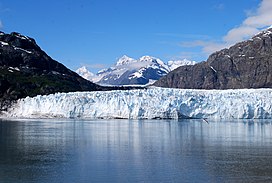Margerie Glacier
| Margerie Glacier | |
|---|---|

Margerie Glacier
|
|
| Type | Tidewater — constrained valley |
| Location |
Glacier Bay National Park Mount Root to Glacier Bay, Alaska |
| Coordinates | 58°58′04″N 137°10′33″W / 58.96778°N 137.17583°WCoordinates: 58°58′04″N 137°10′33″W / 58.96778°N 137.17583°W |
| Length | 21 miles (34 km) |
| Thickness | 350 feet (110 m) |
| Terminus | Sea level |
| Status | Stable |
Margerie Glacier is a 21 mi (34 km) long tidewater glacier in Glacier Bay, Alaska, United States within the boundaries of Glacier Bay National Park and Preserve. The glacier begins on the southern slopes of Mount Root, elevation 12,860 feet (3,920 m), on the Alaska–Canada border flowing southeast down the valley, then turning to the northeast toward its terminus in Tarr Inlet. Margerie Glacier is one of the most active and frequently-visited glaciers in Glacier Bay, which was declared a National Monument in 1925, a National Park and Preserve in 1980, a UNESCO World Biosphere Reserve in 1986 and a World Heritage Site in 1992. While most of the tidewater glaciers in the park have been receding over the last several decades, Margerie Glacier has become stable, neither growing nor receding, while Johns Hopkins Glacier is advancing.
Margerie Glacier extends upstream for a length of 21 miles (34 km) from Tarr Inlet to its source on the southern slopes of Mount Root. The width of the glacier is about 1 mile (1.6 km) and the total height at its terminus is about 350 feet (110 m) including 100 feet (30 m) that is underwater.
In 1750, Glacier Bay was a massive single glacier but due to higher average temperatures and lower average snowfall amounts over the last several centuries it has been transformed into what is now a 65 miles (105 km) fjord with many smaller glaciers. Margerie Glacier is located at the extreme northwestern end of the bay and is situated perpendicular to the Grand Pacific Glacier.
Glacier Bay and its many glaciers are approachable only by air and water as there are no roads in the park. The steep dropoff of Margerie Glacier's terminus allows cruise ships and smaller park tour boats to anchor nearby providing close-up views of ice calving.
Margerie Glacier is named after French geologist and geographer Emmanuel de Margerie who visited the area in 1913. Glacier Bay was completely covered by ice in 1794 when Captain George Vancouver and his expedition were stopped by a wall of ice 20 miles (32 km) wide and 4,000 feet (1,200 m) high. When John Muir first visited the bay in 1879 the ice had retreated 48 miles (77 km) into the bay. The ice wall has since retreated 65 miles (105 km) from the mouth of the bay and is only a remnant of the massive glacier seen by Vancouver. The bay now contains eight tidewater glaciers, including Margerie, within small inlets along its perimeter.
...
Wikipedia
